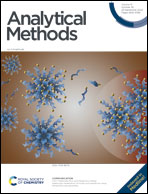A high-performance fluorescent and ratiometric colorimetric detection of Cu2+ in practice†
Abstract
To monitor Cu2+ efficiently, a kind of D–π–A–π–D conjugated 3,5-di-(2-hydroxyl naphthaldehyde)-iminyl triazole (HNIT) was developed, using triazole as the electron acceptor, 2-hydroxyl naphthaline as the electron donor, and –C![[double bond, length as m-dash]](https://www.rsc.org/images/entities/char_e001.gif) N– as the bridging group. The proposed HNIT possessed superior UV-vis and fluorescent spectral property with high molar absorption coefficient of 2.313 × 104 L mol−1 cm−1 and fluorescence quantum yield of 36.2%. Trace Cu2+ could exclusively alter its UV-vis and fluorescent property with clear color change. Under the optimized conditions, a high-performance fluorescent and ratiometric colorimetric detection of Cu2+ based on HNIT was efficient, with low detection limits of 3.3 × 10−8 mol L−1 (S/N = 3) and 9.6 × 10−8 mol L−1 (S/N = 3), respectively. It well satisfied with the safe value of 31.5 μM Cu2+ in drinking water recommended by World Health Organization (WHO). When applied for detection of Cu2+ in real environmental samples, the recovery was in the range of 97.5–105.2%. The recognition mechanism for HNIT to Cu2+ realized quite stable 6-membered rings between electron-deficient Cu2+ and electron-rich N and O atoms in HNIT with 1 : 2 chemical stoichiometry of HNIT to Cu2+.
N– as the bridging group. The proposed HNIT possessed superior UV-vis and fluorescent spectral property with high molar absorption coefficient of 2.313 × 104 L mol−1 cm−1 and fluorescence quantum yield of 36.2%. Trace Cu2+ could exclusively alter its UV-vis and fluorescent property with clear color change. Under the optimized conditions, a high-performance fluorescent and ratiometric colorimetric detection of Cu2+ based on HNIT was efficient, with low detection limits of 3.3 × 10−8 mol L−1 (S/N = 3) and 9.6 × 10−8 mol L−1 (S/N = 3), respectively. It well satisfied with the safe value of 31.5 μM Cu2+ in drinking water recommended by World Health Organization (WHO). When applied for detection of Cu2+ in real environmental samples, the recovery was in the range of 97.5–105.2%. The recognition mechanism for HNIT to Cu2+ realized quite stable 6-membered rings between electron-deficient Cu2+ and electron-rich N and O atoms in HNIT with 1 : 2 chemical stoichiometry of HNIT to Cu2+.



 Please wait while we load your content...
Please wait while we load your content...